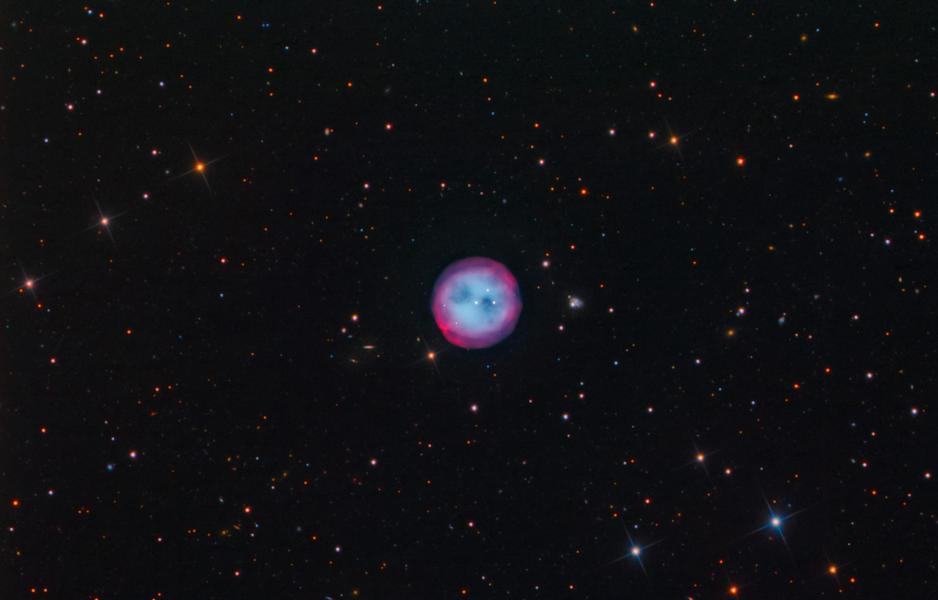M97, the Owl Nebula
|
 |
M97 is a nice example of a planetary nebula. It
is well-sized, though smaller (about half the size) of the
Dumbbell Nebula (M27). Specifically, according to the Seds
Messier database (http://messier.seds.org), the dimensions of
M27 are 8.0 x 5.7 arc-minutes, while M97 is 3.4 x 3.3
arc-minutes in size.
M97 is well-placed in the northern sky, sitting "under" the bowl
of the Big Dipper. As described in the Nebula home page of this
website, this object is the gaseous outer envelopes of a star
similar in mass to our Sun that has completed its red-giant
phase. Undergoing a process that is still not well-understood,
the outer layers of the red giant are being ejected by the
object's central star. Ultraviolet and other radiation from the
central star excite the atoms of the gas being ejected, causing
it to glow and revealing the object to us.
Planetary nebulae don't glow for very long by cosmic standards.
Estimates are that they glow for a few tens of thousands of
years, which is a blink of an eye given a star's typical
lifetime of a few billion years. The reason for the relatively
short lifetime of planetary nebulae is that as the central star
settles down to its white dwarf phase, the radiation that causes
planetary nebulae to glow also fades and the gases stop glowing.
Given M97's estimated age of 8,000 years, we better enjoy this
object while it lasts!
M97 is nicknamed the Owl Nebula thanks to an illustration by
William Parsons, the 3rd Earl of Rosse. His observation and
hand-drawn illustration resembled an owl's head, most likely
from the two dark lobes visible even in my image.
Source: Wikipedia, Seds database |
| |
|
Constellation: Ursa Major |
|
When Visible: January - July |
|
Distance: 2,000 Light-years |
|
Date: March 2014 |
|
Location: Rancho Hidalgo, New Mexico |
Exposure Details:
Luminance: 17 x 10 Minutes Binned 1x1
H-Alpha: 22 x 30 Minutes Binned 1x1
R: 13 x 10 Minutes binned 1x1
G: 13 x 10 Minutes binned 1x1
B: 13 x 10 Minutes binned 1x1 |
| |
| Equipment used: 12.5" PlaneWave
CDK on a Software Bisque Paramount ME mount. SBIG STL-6303
camera with 5-position filter wheel and Astrodon LRGB filters. |
| |
| Acquisition Software :
MaximDL, CCDAutopilot 5, TheSky6, FocusMax |
| Processing Software: Software:
MaximDL, Adobe Photoshop CS5 Gradient Xterminator, Carboni
Tools, IrFanView |
|
|
